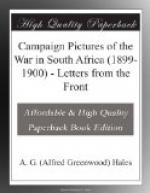Meantime the R.H. Battery, taking range from Lieutenant Aide’s fire, opened out on the enemy. Their guns put a great fear into the Boers, and a general bolt set in. The Boers fired as they cleared, and if our fellows had been formed up in the style usual to the British army in action, we should have suffered heavily; but the Queensland bushmen had dropped behind cover, and soon had complete possession of the kopjes; another trooper named Victor Jones was shot through the brain, and fourteen others were more or less badly wounded. The Boers then surrendered. We took 40 prisoners, and found about 14 dead Boers on the ground, besides a dozen wounded. They were all Cape Dutch, no Transvaalers being found in their ranks. We secured 40,000 rounds of their ammunition, 300 Martini rifles, and only one Mauser rifle, which was in the possession of the Boer commander. After destroying all that we took, we moved on, and had a look at some of the farms near by, as from some of the documents found in camp it was certain that the whole district was a perfect nest of rebellion. Quite a little store of arms and ammunition was discovered by this means, and the occupants of the farms were therefore transported to Belmont. Our fellows carried the little children and babies in their arms all the way, and marched into Belmont singing, with the little ones on their shoulders. Every respect was shown to the women, old and young, and to the old men, but the young fellows were closely guarded all the time. The Canadians did not lose a single man, neither did any of the others except the Queenslanders.
Another Boer commando, about 1,000 strong, with two batteries of artillery, is now hovering in the ranges away to the north-west of Enslin, but Colonel Hoad is not likely to be tempted out to meet them, since his orders are to hold Enslin against attack. However, should they venture to make a dash for Enslin, they will get a pretty bad time, as the Australians there are keen for a fight.
Concerning farming, it is an unknown quantity here, as we in Australia understand it. These people simply squat down wherever they can find a natural catchment for water. There is no clearing to be done, as the land is quite devoid of timber. They put nigger labour on, and build a farmhouse. These farmhouses are much better built than those which the average pioneer farmer in Australia owns. They make no attempt at adornment, but build plain, substantial houses, containing mostly about six rooms. The roofs are mostly flat, and the frontages plain to ugliness. They do no fencing, except where they go in for ostrich breeding. When they farm for feathers they fence with wire about six feet in height. This kind of farming is very popular with the better class of Boers, as it entails very little labour, and no outlay beyond the initial expense. They raise just enough meal to keep themselves, but do not farm for the market. They breed horses and cattle; the horses are a poor-looking lot, as the




